Baked sauerkraut (podvarak) is a signature Balkan winter dish. Tangy fermented cabbage is baked together with flavorful meats resulting in a phenomenal side dish (or a main course!). Shall we?

Jump to:
Background
Podvarak is a dish of sauerkraut baked with meat. It's both a side and a main course. It's simple, tasty and versatile.
It's a typical comfort dish prepared with fermented (sour) cabbage popular in the Balkans, Central and Eastern Europe.
Baked sauerkraut (podvarak) goes splendidly with sides like mashed potatoes, rice, or polenta. It's a surprisingly great recipe you'll enjoy making all through the winter months.
Ingredients
Here are the ingredients you'll need to make baked sauerkraut (podvarak).
These are just the suggestions. Please adjust to your dietary needs and preferences.
Baked sauerkraut is a forgiving dish, and you can let your imagination run wild here.
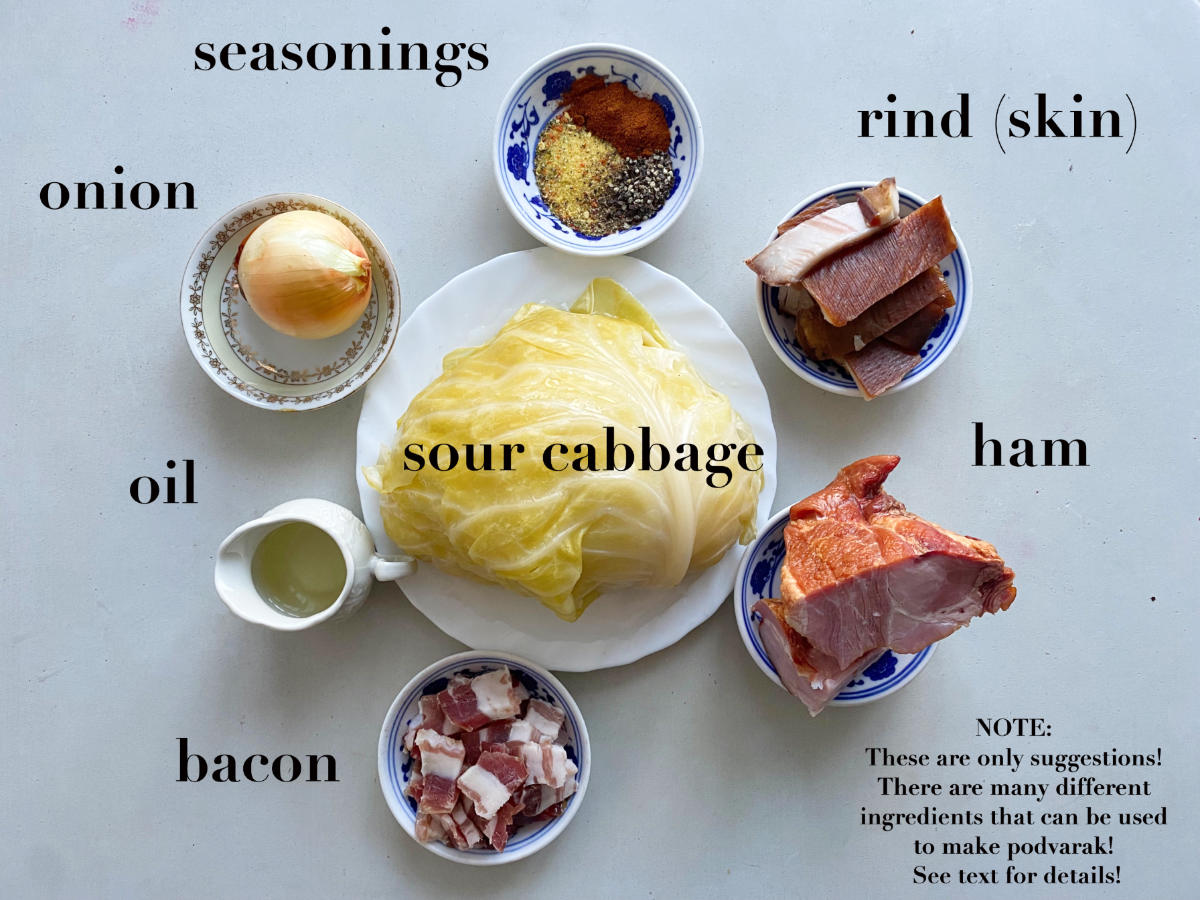
- Sauerkraut: homemade sour cabbage (whole or shredded), cabbage from a jar, or bagged cabbage are all great options. Note: taste the cabbage before making it. If it's too salty, simply rinse it in lukewarm water once or twice.
- Meat: If making baked sauerkraut (podvarak) as a side, choose smoked beef, bacon, ham, and/or prosciutto, etc. However, if making it as the main course, add bigger pieces of meat like lamb, spare ribs, sausages, roast pork, chicken, or turkey legs and thighs, etc.
- Onion: yellow or white. Avoid red.
- Seasonings: red paprika, Vegeta (or bouillon), peppercorn, black pepper.
- Oil: vegetable, sunflower, canola, avocado, etc. Avoid olive oil.
- (Optional) Rice. Some add 4-6 tablespoons rice.
- (Optional) Potato.
Instructions
Here are the instructions for baked sauerkraut (podvarak).
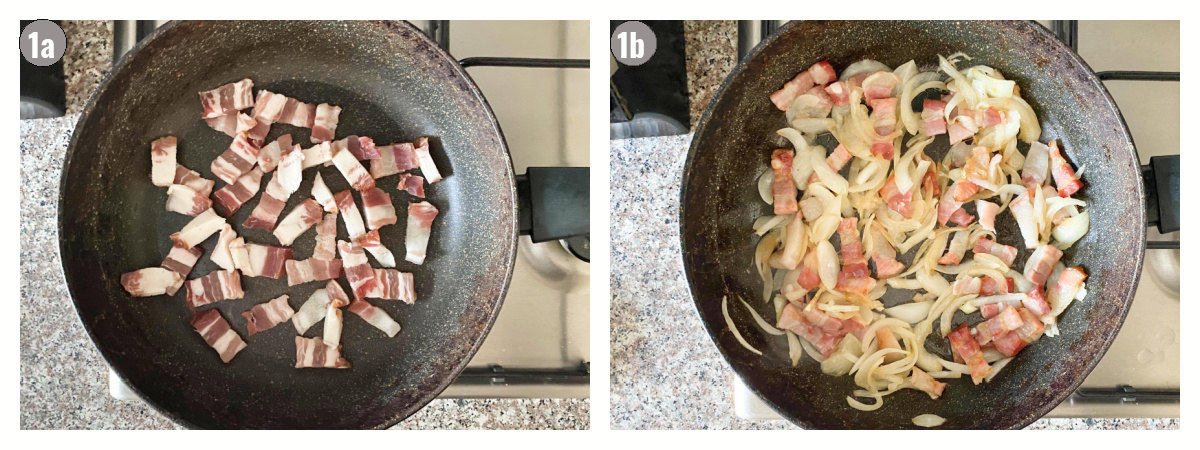
Step 1 for Baked Sauerkraut (podvarak).
In a deep pan, heat bacon (if using it, otherwise start with onion) until it starts expelling its grease. Add onion (and more oil if necessary), and cook until translucent.

Step 2 for Baked Sauerkraut (podvarak).
Transfer bacon and onion to the pan (preferably baking glassware). Add more oil if necessary. Top with any additional meats, meat rinds, seasonings, and sauerkraut. Mix well.
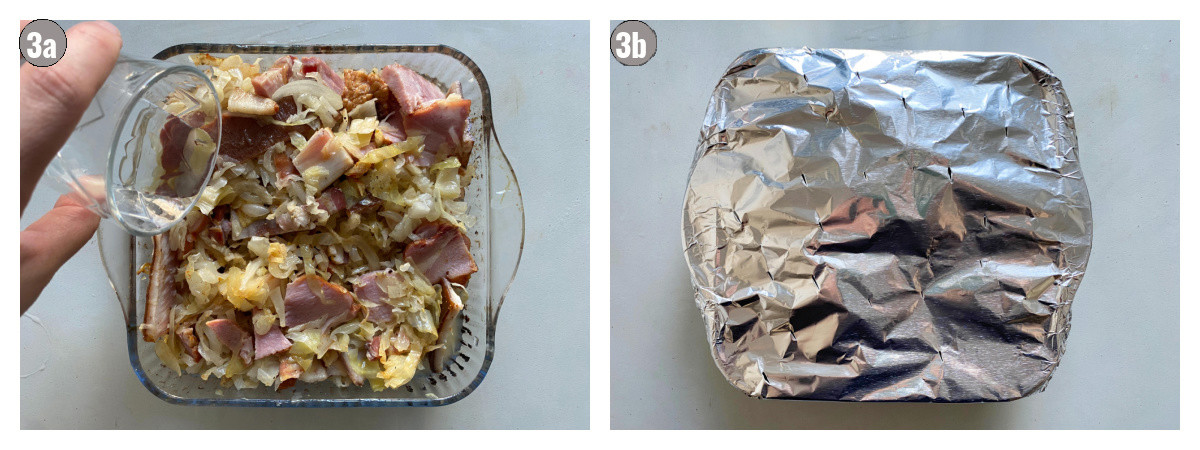
Step 3 for Baked Sauerkraut (podvarak).
Add 1-1.5 cups of water. Cover with foil. Pierce foil for steam to come out. Bake. (Not pictured.) During baking, check and add a little more water if necessary. Uncover the last 15 minutes.

Recipe FAQs
Sour cabbage is incredibly nutritious! In addition to fiber, it also contains Vitamin B complex, Vitamins A and C, calcium, magnesium, potassium, phosphorus, and manganese. Talk about gut health!
Absolutely! There have been numerous studies done on fermented cabbage! Sour cabbage is shown to have antioxidant and anti-inflammatory properties, as well as anti-cancerogenic properties. It acts as a probiotic, and it's an incredible Vitamin C source.
Podvarak is both a main course and a side. It all depends on how much podvarak you plan to make, and what meat you plan to make it with.
To transform podvarak into a main course, add a larger piece of meat like a few sausages, turkey (or chicken) legs and thighs, or ham. To fortify the dish add a side of mashed potatoes, polenta, quinoa, and/or rice.
Podvarak is consumed throughout ex-Yugoslavia, and wider Balkans, including those three countries.
Differences in recipes are usually based on the meats used to make the dish. These depend on people's needs and preferences due to different religious and/ or dietary needs.
Sour cabbage that's gone through more than one process of cooking (baking, frying) can sometimes end up being too tough or dry out.
Baking podvarak (without processing it before via frying or cooking) gives it the most perfect texture. Covered with foil, baked in the oven with just the right amount of liquid, it's almost as if the dish is steaming, baking, and cooking at the same time. The result is the unbelievably soft yet crunchy baked sauerkraut with golden overtones.
However, this is just our way of doing it, and by no means the only way to make baked sauerkraut.
Handling
- Serving: serve warm to hot by itself or as a side. Good sides are polenta, rice, mashed potatoes, homemade bread etc.
- Storing: cover with foil (or transfer to an airtight container), and store in the fridge or a very cool balcony for up to 2-3 days.
- Freezing: freeze for up to 2-3 months. Take out a few hours before you plan to eat it. Let it thaw and then reheat. Add fluid/ water as necessary.
- Reheating: reheat based on your preference. We recommend reheating it on the stovetop, on the lowest setting. Add fluid/water as necessary.
More Cabbage Recipes
If you love cabbage, here are some ideas to get you started.
Thoughts?
If you made baked sauerkraut (podvarak) and liked it, please consider giving it a ⭐️⭐️⭐️⭐️⭐️ (5-star) rating. This helps others find the recipe more easily!
Also, feel free to leave a comment (I read each one!), and don't forget to tag a photo #balkanlunchbox, or us @balkanlunchbox, on IG.
Prijatno, Dobar Tek, and Bon Appetit!
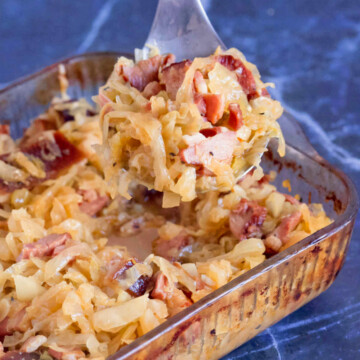
Baked Sauerkraut (Podvarak)
Equipment
- 1 13x13 inches baking pan (approximately 33x33 cm) preferably glassware
Ingredients
- 1-2 yellow or white onions sliced
- 10-12 ounces cured meats (prosciutto, smoked beef, bacon, ham, etc.), if making a side dish if making this as the main course, add more meat like chicken or turkey legs and thighs, ham, ribs, lamb chops, sausages, roast pork, etc.
- 2-3 pounds sour cabbage (sauerkraut), or about ½ head of sour cabbage bagged, jarred, or homemade sauerkraut
- 2 tablespoons peppercorn
- 1 teaspoon black pepper
- 2-3 tablespoons paprika (more works too!) mild or hot, as per preference
- 1-2 tablespoons stock powder or Vegeta or 1-2 bouillon cubes, crushed
- 2-3 tablespoons oil vegetable, sunflower, avocado, etc.
- (Optional) meat rinds take out after baking
- 1-2 cups water
Instructions
- Heat oven to 480°F (250°C).
- In a frying pan add bacon (or any cured meats with fat on it), and heat up on medium, occasionally stirring. When the meat starts to warm up and/or melt, add onion. (If the pan is dry, add 1-2 tablespoons of oil as well.)
- Fry everything an additional 4-5 minutes, or until the onion starts to sweat. Stir occasionally. (The meat should not be completely fried!) Transfer to the baking pan.
- Try the sauerkraut. If it's too salty for your taste, wash it in lukewarm water. Drain and slice thinly. (Even if it is shredded, slice it a little bit thinner.)
- Add sauerkraut and seasonings to the baking pan. Add any meat rinds, or remaining cured meat as well. Mix all the ingredients really well. (If making this as the main course, place the big pieces of meat on top, after you mix everything.) Add 1-2 glasses of water to the pan.
- Cover the pan with foil, and pierce several small holes for the steam to get out. Lower the heat to 400°F (200°C), and transfer the pan to the oven. Bake for 90 minutes.*
- About 60 minutes into the baking, take the pan out of the oven. Carefully lift the foil away from yourself, and check the fluid level. If it's running low, add a little more water. Fasten the foil again, and return to the oven for the remainder of the time.
- After 90 minutes in total, lower the temperature to 300°F (150°C), and take the foil off. Bake without foil for an additional 15 minutes.*
- Serve: warm to hot by itself or as a side like polenta, rice, mashed potatoes, homemade bread. (Remove meat rinds before serving.) Store: in an airtight container (or foil) in the fridge or a very cool balcony for up to 2-3 days. Freeze for up to 2-3 months. Take out a few hours before you plan to eat it. Let it thaw and then reheat. Add fluid/ water as necessary. Reheat based on your preference. We recommend reheating it on the stovetop, on the lowest setting.


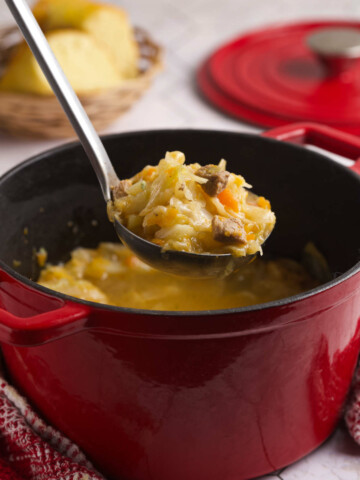


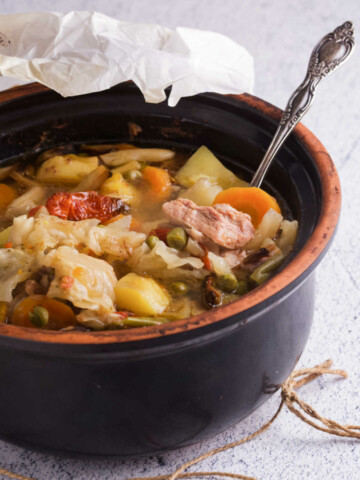

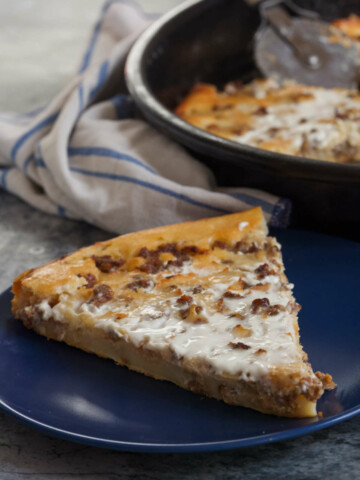
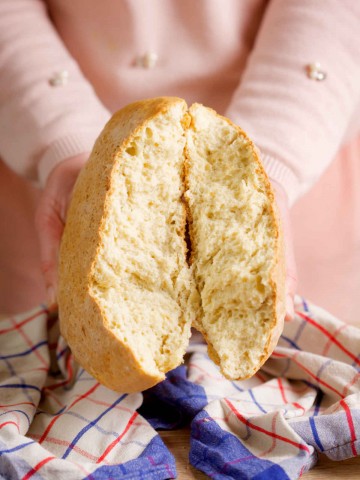
Sandra Hanisch says
Yummy and so simple. I looked and looked through all kinds of websites for what to do with a sour cabbage head that I bought having no idea what to do with. Delicious! Thank you
Aida says
Bon appetit Sandra!
MB says
Awesome
Aida says
❤️